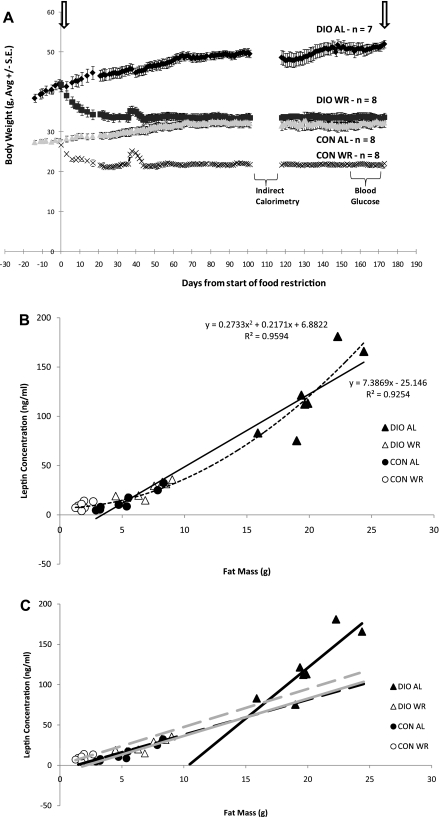Fig. 1.
A: Means ± SE body weight (g) of 4 groups of 22-wk-old mice from start of food restriction protocol. Arrows represent 4-h fasted bleeding. Small upward inflections in body weights of diet-induced obese-weight-reduced (DIO-WR) and never-obese-WR control (CON-WR) mice (days 36–43) was due to a batch of corncob-based bedding containing corn kernels, a situation that was resolved by switching mice to wood-based bedding material on day 39. B: leptin (ng/ml) to fat mass (FM; g). Linear regression using DIO-ad libitum-fed (DIO-AL) and CON-AL mice; solid line. Nonlinear regression using all mice groups; dashed line. C: relationship between leptin and FM in DIO-AL (▴, black solid line), DIO-WR (▵, black dashed line), CON-AL (●, grey solid line), and CON-WR (○, grey dashed line) animals. DIO-AL: leptin = 12.6 (FM) to 130.3, r = 0.85, P = 0.014 ; DIO-WR: leptin = 4.3 (FM) to 5.4, r = 0.84, P = 0.009; CON-AL: leptin = 4.6 (FM) to 9.8, r = 0.95, P = 0.0003; CON-WR: leptin = 4.7 (FM) + 0.4, r = 0.53, P = 0.17. There was no statistically significant linear relationship of leptin to FM in CON-WR animals. There was no significant difference in the relationship of leptin to FM between DIO-WR and CON-AL groups. The slope of the regression was significantly greater and the intercept significantly lower in DIO-AL compared with DIO-WR and CON-AL.

